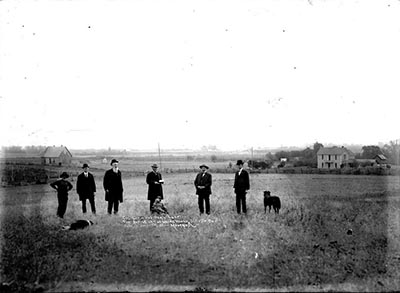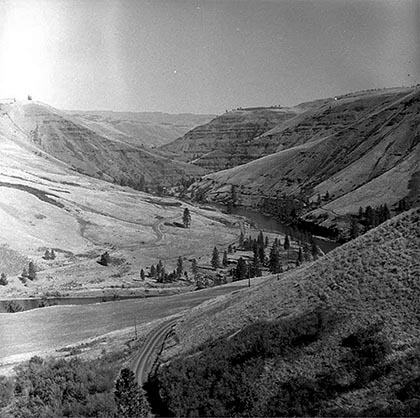The Oregon Trail's number-one used-oxen dealership
In the 1840s, Native American tribes in the Grand Ronde Valley made good money buying emigrants' shagged-out oxen for half price and selling them the following year for double price; emigrants griped a lot, but most didn't hesitate to pay.
EDITOR'S NOTE: A revised, updated and expanded version of this story was published in 2017 and is recommended in preference to this older one. To read it, click here.

Aged pioneers pose near the scene of a battle with a group of Native
Americans in the Grand Ronde Valley in 1907. (Image: UO Archives)
By Finn J.D. John — December 21, 2009
In the midst of some of the roughest and least hospitable country in the west, the Grande Ronde Valley is a bit like an oasis. Or, at least, that’s how it seemed to the emigrant parties that came through, headed for the Willamette Valley on the Oregon Trail.
The valley itself follows the Grande Ronde River through northeast Oregon, surrounded by the Blue Mountains with the Wallowas to the east and the Eagle Cap Wilderness to the south. It’s actually surprisingly tiny – maybe 15 miles wide and 35 miles long. But for hundreds of generations, it has been known to locals as a highly productive little Garden of Eden.
It was an especially important part of the Oregon Trail, from the 1840s up until the Civil War broke out. Once an emigrant party had made it to the Grande Ronde Valley, it had straggled across hundreds of miles of the Great Plains, crossed the Continental Divide in Wyoming and thrashed through hundreds more miles of the Rocky Mountains and the blistering, arid Snake River Desert in Idaho – throughout which they were constantly fighting off attacks by hostile Indian tribes. By the time a party got to this tiny, fertile valley, it was typically pretty played-out.

A view of the lush, fertile Grand Ronde Valley as seen from a promontory
in 1960. (Image: Ben Maxwell/ Salem Public Library)
This was more applicable to the animals than the people. After all, the people could rest when they needed to, sitting on the wagon while the oxen dragged it up yet another mountain pass. But those oxen – when they got skinny from lack of forage, unhealthy from lack of rest and exhausted from too much work, nothing the emigrants could give them on the trail would help them recover. What they needed was a month on good grass with no load behind them. They needed to be pastured. They needed to rest.
And that’s where the Native Americans in the region could help … for a fee.
The Nez Pierce, Cayuse, Walla Walla and Umatilla tribes had no use for oxen, except maybe for the occasional bad winter when better meats were unavailable. But they quickly figured out that they could make a lot of money on them.
These tribes would take skinny, exhausted draft animals off the emigrants’ hands for, basically, 50 percent of their value. Then they’d equip the party with fresh draft animals and send them on their way to the Willamette Valley.
Where did the fresh oxen come from? Last year’s emigrants, of course. The Indians had bought exhausted oxen from last year’s travelers and pastured them out on the lush grasslands of the Grande Ronde Valley. A year later they were fresh and ready to take a new crop of emigrants west, across the rest of the mountains to the Willamette Valley – and there were another 300 miles or so of Blue Mountains, Cascade Range and terrifying river voyages still ahead before the parties would get there.
It was a classic win-win situation. Emigrant parties whose livestock would never have pulled through got a fresh set, and tribes got a nice revenue stream, plus a supply of emergency food for the winter.
With their customers desperate, the Native Americans could charge almost anything they liked for their fresh oxen; the wonder isn’t that they marked them up 100 percent, but that they didn’t mark them up more. Of course, that didn’t stop some of the emigrants grumbling about it.
“The Nez Pierce can beat a Yankee peddler in a trade,” one exasperated – and out-of-pocket – emigrant groused.
(Sources: Gulick, Bill. Roadside History of Oregon. Missoula: Mountain Press, 1991; Wagner, Tricia M. It Happened on the Oregon Trail. Guilford, Conn.: Globe Pequot, 2005)
-30-











